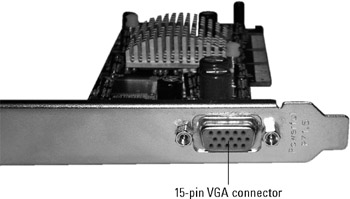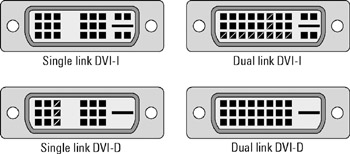Digital or Analog?
Until flat-panel monitors began to replace the older cathode ray tubes (CRTs) in computer monitors, all monitors were analog devices that used a continuous stream of data to control a set of three electrons gun inside the CRT, which would scan across the phosphorescent surface of the screen to light selected areas (pixels) in red, green, or blue, which your eye combines into full-color images. This is the same technology that is used in traditional broadcast television. Because the computer and the graphics controller process the image as a series of digital signals, the controller must use a digital-to-analog converter (the RAMDAC) to create the analog signal.
In a digital monitor, the graphics controller sends a separate signal to control each pixel, so it's not necessary to include a RAMDAC in the path from the processor to the monitor. Flat-panel monitors are all digital, although some early ones had analog inputs to make them compatible with the analog outputs of existing video cards. Today, most flat-panel monitors have digital inputs, so the latest models of graphics controllers have digital outputs that bypass the RAMDAC. Many graphics cards include both analog and digital outputs on separate connectors.
If you have a choice, it's better to use a digital link between a graphics controller and an LCD monitor, because an analog connection requires conversion from digital to analog through the RMADAC, and then back to digital inside the monitor. Converting from digital to analog and back again slows down the transfer speed from the controller to the monitor and it might cause a slight reduction in the image quality.
The standard analog video output from a graphics controller is a 15-pin VGA (video graphics adapter) connector like the one shown in Figure 10.10. Most analog monitors have a captive VGA cable that is permanently connected to the case.

Figure 10.10: Analog monitors use 15-pin VGA connectors.
Digital outputs use a Digital Video Interface (DVI) cable, based on the Transition Minimized Differential Signaling (TMDS) standard. TMDS uses one or more transmitters in the graphics card to send data to an equal number of receivers in the monitor. A single link cable can support image resolutions up to 1920 × 1080. A dual link connection can increase the resolution to 2048 × 1536. DVI connections may be digital only (DVI-D), or DVI-integrated (DVI-I) that can support both digital and analog monitors. DVI connectors use three rows of eight pins or receptacles for the digital signal, and four isolated pins for the analog signal. Figure 10.11 shows single link and dual-link DVI-D and DVI-I connectors.

Figure 10.11: DVI connectors and receptacles come in four different configurations.
Some graphics adapters also have a third type of output connector, probably labeled TV Out. A cable from this output can connect to the S-Video or composite video connector on many television sets.
EAN: 2147483647
Pages: 372